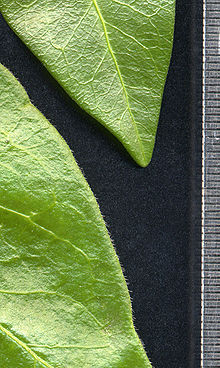en
names in breadcrumbs


Vinca minor (common names lesser periwinkle[1] or dwarf periwinkle) is a species of flowering plant in the dogbane family, native to central and southern Europe, from Portugal and France north to the Netherlands and the Baltic States, east to the Caucasus, and also southwestern Asia in Turkey. Other vernacular names used in cultivation include small periwinkle, common periwinkle, and sometimes in the United States, myrtle or creeping myrtle.[2]

Vinca minor is a trailing subshrub, spreading along the ground and rooting along the stems to form large clonal colonies and occasionally scrambling up to 40 centimetres (16 in) high but never twining or climbing. The leaves are evergreen, opposite, 2–4.5 centimetres (0.79–1.77 in) long and 1–2.5 centimetres (0.39–0.98 in) broad, glossy dark green with a leathery texture and an entire margin.
The flowers are solitary in the leaf axils and are produced mainly from early spring to mid summer but with a few flowers still produced into the autumn; they are violet-purple (pale purple or white in some cultivated selections), 2–3 centimetres (0.79–1.18 in) diameter, with a five-lobed corolla. The fruit is a pair of follicles 2.5 centimetres (0.98 in) long, containing numerous seeds.
The closely related species Vinca major is similar, but larger in all parts, and also has relatively broader leaves with a hairy margin.
The species is commonly grown as a groundcover in temperate gardens for its evergreen foliage, spring and summer flowers, ease of culture, and dense habit that smothers most weeds. It was once commonly planted in cemeteries in parts of the Southern United States and naturalized periwinkle may indicate the presence of graves whose other markers have disappeared.[3]
The species has few pests or diseases outside its native range and is widely naturalised and classified as an invasive species in parts of North America. Invasion can be restricted by removal of rooting stems in spring.[4] Once established, it is difficult to eradicate, as its waxy leaves shed most water-based herbicide sprays. However, spraying with glyphosate easily kills the plant in 2-3 weeks. Removal involves cutting, followed by immediate application of concentrated glyphosate or triclopyr to the cut stems. Repeated chemical treatments may be necessary, along with digging up the roots where feasible.[5]
There are numerous cultivars, with different flower colours and variegated foliage. Many have a less vigorous habit than the species, and are therefore more suitable for smaller gardens. The following cultivars have gained the Royal Horticultural Society's Award of Garden Merit:-[6]
Vinca minor contains more than 50 alkaloids, including vincamine.[12] Other alkaloids include reserpine, rescinnamine, akuammicine, majdine, vinerine, ervine, vineridine, tombozine, vincamajine, vincanine, vincanidine,[13] vinburnine, apovincamine, vincaminol, desoxyvincaminol,[14] vincorine[15] and perivincine.[16]
Vinpocetine (brand names: Cavinton, Intelectol; chemical name: ethyl apovincaminate) is a semisynthetic derivative alkaloid of vincamine.
The colour name periwinkle is derived from the flower.
Vinca minor (common names lesser periwinkle or dwarf periwinkle) is a species of flowering plant in the dogbane family, native to central and southern Europe, from Portugal and France north to the Netherlands and the Baltic States, east to the Caucasus, and also southwestern Asia in Turkey. Other vernacular names used in cultivation include small periwinkle, common periwinkle, and sometimes in the United States, myrtle or creeping myrtle.
 Leaf margins for comparison; Vinca minor above, Vinca major below; note hairless margin of V. minor, hairy margin of V. major. Scale in mm.
Leaf margins for comparison; Vinca minor above, Vinca major below; note hairless margin of V. minor, hairy margin of V. major. Scale in mm.